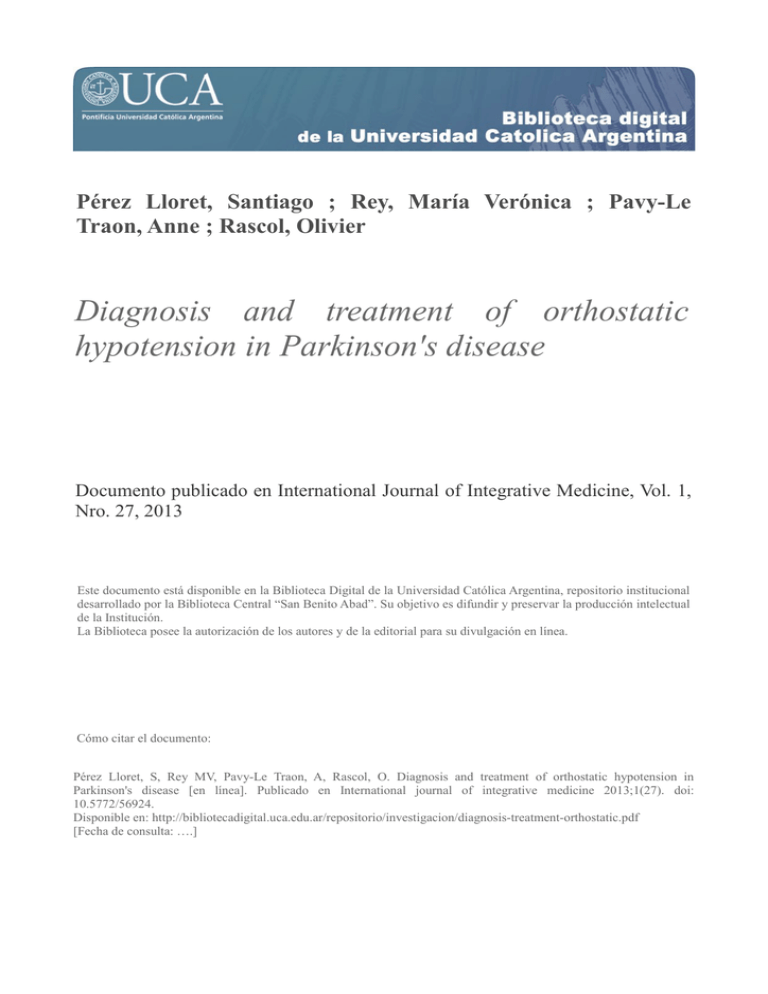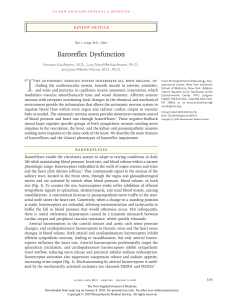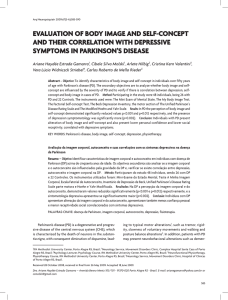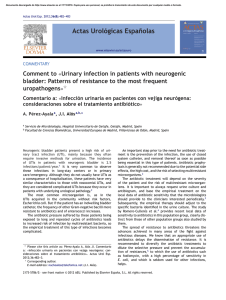Diagnosis and treatment of orthostatic
Anuncio

Pérez Lloret, Santiago ; Rey, María Verónica ; Pavy-Le Traon, Anne ; Rascol, Olivier Diagnosis and treatment of orthostatic hypotension in Parkinson's disease Documento publicado en International Journal of Integrative Medicine, Vol. 1, Nro. 27, 2013 Este documento está disponible en la Biblioteca Digital de la Universidad Católica Argentina, repositorio institucional desarrollado por la Biblioteca Central “San Benito Abad”. Su objetivo es difundir y preservar la producción intelectual de la Institución. La Biblioteca posee la autorización de los autores y de la editorial para su divulgación en línea. Cómo citar el documento: Pérez Lloret, S, Rey MV, Pavy-Le Traon, A, Rascol, O. Diagnosis and treatment of orthostatic hypotension in Parkinson's disease [en línea]. Publicado en International journal of integrative medicine 2013;1(27). doi: 10.5772/56924. Disponible en: http://bibliotecadigital.uca.edu.ar/repositorio/investigacion/diagnosis-treatment-orthostatic.pdf [Fecha de consulta: ….] ARTICLE International Journal of Integrative Medicine Diagnosis and Treatment of Orthostatic Hypotension in Parkinson’s Disease Review Article Santiago Perez-Lloret1,2,*, María Verónica Rey1, 2, Anne Pavy-Le Traon2, Olivier Rascol2 1 Laboratory of Clinical Pharmacology & Epidemiology, Pontifical Catholic University, Buenos Aires, Argentina 2 Departments of Clinical Pharmacology and Neurosciences, and Clinical Investigation Center CIC9302, INSERM and University Hospital, University of Toulouse III, Toulouse, France * Corresponding author E-mail: [email protected] Received 1 Aug 2013; Accepted 8 Aug 2013 © 2013 Perez-Lloret et al.; licensee InTech. This is an open access article distributed under the terms of the Creative Commons Attribution License (http://creativecommons.org/licenses/by/3.0), which permits unrestricted use, distribution, and reproduction in any medium, provided the original work is properly cited. Abstract Orthostatic hypotension (OH) is a frequent comorbidity affecting between 23 and 38% of Parkinson’s disease (PD) patients. Several pieces of evidence suggest that OH is related to faster cognitive decline and more frequent falls, and has been also connected to increased mortality. OH can be arbitrarily defined as a drop of systolic and/or diastolic blood pressure of 20 or 10 mmHg or more in the first three minutes after passing from decubitus to an upright position. Till test appears to be the most reliable tool for assessing the orthostatic response. On the other hand, the standing test and evaluation of orthostatic symptoms should be regarded as screening tests. The key physiopathological aspect of OH is an altered baroreflex function resulting from cardiac and vascular sympathetic denervation. Nonetheless, OH can be aggravated by heat, alcohol consumption or by drug treatments, such as antihypertensives, dopamine agonists or amantadine. Treatment should begin with re‐considering drug treatments. After treatment is optimized, non‐ pharmacological measures may be employed. Drugs treatment should be reserved for patients in whom other strategies have failed. Midodrine and fludrocortisone are the most frequently used treatments, even though evidence about their efficacy and safety is weak. www.intechopen.com Midodrine has a shorter duration of action and thus avoidance of evening dosing may help keep nocturnal blood pressure dipping intact. Promising alternatives may include droxidopa and fipamezole. Keywords Orthostatic Hypotension, Treatment, Parkinson’s Disease, Midodrine, Integrative Medicine 1. Introduction Autonomic disturbances including orthostatic hypotension, constipation, hypersalivation or excessive sweating are frequent features of Parkinson’s disease (PD) [1, 2]. They can impair a patient’s quality of life, worsen caregiver burden, lead to hospitalization and institutionalization, and increase the cost of care of patients with PD [1]. Their management and treatment have been recognized by the UK National Institute for Clinical Excellence as unmet needs in PD [3]. A variety of neurocirculatory abnormalities have been noted in PD, orthostatic hypotension (OH) being the most j. integr. med., 2013, Vol. 1, 27:2013 Santiago Perez-Lloret, María VerónicaInt. Rey, Anne Pavy-Le Traon, Olivier Rascol: Diagnosis and Treatment of Orthostatic Hypotension in Parkinson’s Disease 1 frequent and incapacitating one [4]. OH can cause falls and increase the risk of cognitive dysfunction [5] and is a predictor of all‐cause mortality [6]. These data emphasize the importance of its prompt recognition and treatment. In this review we will deal with the epidemiology, clinical evaluation and treatment of orthostatic hypotension in PD. We will begin by briefly discussing its physiopathology. 2. Physiopathology In PD, orthostatic hypotension may results from the disease process as well as from extrinsic influences [4]. General extrinsic factors include older age and drug treatments [7, 8, 9]. Excessive heat has been related to more frequent and more severe OH‐related events, such as syncope [10]. Alcohol elicits hypotension during orthostatic stress because of impairment of vasoconstriction, as has been shown in healthy young volunteers [11]. Other risk factors include female gender, diabetes, low body mass index or smoking. As mentioned, exposure to drugs can either cause or aggravate OH. For example, we have recently observed that OH was more frequent in subjects exposed to diuretics or amantadine and those exposed to five or more drugs at the same time (i.e., polypharmacy) [8]. Some studies have also suggested that OH is more frequent in patients on dopamine agonists [12, 13] but not on levodopa [12, 14]. In any case, orthostatic hypotension is also present in recently diagnosed “de novo” PD patients, suggesting that it is independent of dopaminergic replacement therapy [15]. OH is also related to PD severity [16], further suggesting that disease‐related factors also play a role in OH development. Altered baroreflex appears to be the hallmark of OH in PD. The baroreflex is the main short‐term compensatory mechanism to buffer blood pressure changes and maintain circulatory homeostasis. Briefly, blood pressure variations are sensed by arterial or venous baroreceptors (Figure 1) [17]. The information is conveyed to the brainstem, where autonomic nervous system activity is modified to revert blood pressure fluctuations. Patients with PD and OH have low baroreflex‐cardiovagal gain compared to healthy controls [4, 18]. Altered baroreflex function results mainly from postganglionic sympathetic denervation [19] (Figure 1). Such lesions result in altered autonomic control of cardiac function as shown by the reduction in heart rate variability observed in PD [20]. Reduced sympathetic tone is also observed in blood vessels, which is the other effector of baroreflex [4, 21]. The alterations leads to impaired haemodynamic 2 Int. j. integr. med., 2013, Vol. 1, 27:2013 responses to blood pressure drop, which would normally induce increased cardiac output by increased heart rate and myocardial contractility and peripheral resistance by vasoconstriction. 3. Epidemiology Several studies have investigated the prevalence of OH in PD. A recent systematic review and meta‐analysis assessed the prevalence if OH in PD in retrospective, cross‐sectional, or prospective cohort studies involving undemented PD patients [22]. The prevalence rate across the 25 studies included in the analysis ranged from 9.6% to 64.9% with a pooled prevalence of 30.1% (95% CI: 22.9‐ 38.4%). Study characteristics, such as methodological quality, risk of selection bias, sample size, OH definition and the complexity level of the centre where the study was carried out did not influence prevalence figures. These results lie in the range stated in previous non‐ systematic reviews concerning this subject [23]. In some cases, OH can precede PD diagnosis [23, 24], but the prevalence of OH as a presenting symptom remains unknown. 4. Clinical evaluation of OH in PD OH can be operationally defined as a sustained reduction of systolic blood pressure of at least 20mm Hg or diastolic blood pressure of 10mm Hg within three minutes of standing (i.e., Schellong test) or head‐up tilt to at least 60° on a tilt table [25]. Tilt testing for up to ten minutes appears to be the most reliable method for evaluation of OH [26]. On the other hand, the presence of orthostatic symptoms and results from the standing test can only be considered as screening tools. Beat‐to‐beat blood pressure using non‐invasive measurement during a Valsalva manoeuvre can be of help during the evaluation of neurogenic OH. Systolic blood pressure decreases progressively during the manoeuvre, increasing slowly toward the baseline value with no pressure overshoot after release of the manoeuvre [27]. BP responses to deep breathing can also be analysed. Plasmatic norepinephrine change after and the orthostatic test can be used to assess denervation of blood vessels. Cardiac responses can be assessed by analysing heart rate variability. OH can be symptomatic or asymptomatic. When present such symptoms may include light‐headedness, dizziness, presyncope and syncope [25, 28]. Weakness, fatigue, cognitive slowing, leg buckling, visual blurring, hearing disturbances, headache, hanger‐coat pain, orthostatic dyspnoea or chest pain can also sometimes be observed [28]. www.intechopen.com Figure 1. Baroreflex function in healthy subjects (A) and in PD patients (B). In PD, post‐ganglionic sympathetic denervation leads to blunted responses to reduced blood pressure, which would otherwise lead to increased cardiac output and peripheral resistance. The presence and severity of orthostatic symptoms in PD may be evaluated by the AUTonomic SCale for Outcomes in PArkinson’s disease (SCOPA‐Aut) or the COMPosite Autonomic Symptom Scale (COMPASS) [29]. The SCOPA‐AUT is a brief, reliable, validated and easily self‐administered questionnaire for assessing the frequency and burden of autonomic dysfunction in PD patients. On the other hand, COMPASS is a complex and long questionnaire, which has not been specifically validated for use in PD. As mentioned earlier, assessment of OH symptoms can only be considered as a screening test since the agreement between blood pressure decreases during an orthostatic challenge and OH symptoms is very poor both in PD [8, 26] and in the general population [30]. www.intechopen.com 5. Treatment Identification of the mechanism of orthostatic hypotension (disease, drug or other causes) is the first step in the treatment, followed by non‐pharmacological measures. Exposure to diuretics, amantadine and polypharmacy, dopamine agonists, alpha‐adrenergic blockers used for prostatic hyperplasia, clonidine or many antidepressants should be appraised and reconsidered [8, 9, 31]. Patients should also be advised to avoid precipitating factors such as sudden postural change, large meals, hot baths, alcohol and vasodilating medications [32]. Other non‐ pharmacological methods for treating OH include addition of salt to the diet, exercise, compression stockings or physical manoeuvres that help to raise blood pressure. Santiago Perez-Lloret, María Verónica Rey, Anne Pavy-Le Traon, Olivier Rascol: Diagnosis and Treatment of Orthostatic Hypotension in Parkinson’s Disease 3 Drug Midodrine Fludrocortisone Droxidopa Fipamezole Status Approved for neurogenic OH in USA and Europe Approved in USA and Europe, but used off‐label in OH Dose 5‐10 mg/day 0.1‐0.3 mg/day Experimental. In PD it reduced risk of fall but not OH Experimental, in Phase III 200‐300 mg/day 30‐90 mg/day Effect duration Safety 2‐4 hs supine hypertension, paresthesias and goose‐bumps days nausea, chest discomfort, nocturnal hypertension, hypocalcaemia, postural oedemas, Addison syndrome hours tachycardia, hypertension, nausea and vomiting, headache hours hypertension, atrial fibrillation, presyncope and tachycardia Table 1. Pharmacological treatment of orthostatic hypotension in PD. In patients with insufficient or absent responses, pharmacological options should be offered, midodrine or fludrocortisone being the first line treatments. Nonetheless, a recent systematic review demonstrated that several common pharmacological or non‐ pharmacological treatments for orthostatic hypotension have been examined only in low‐quality trials [33]. Similarly, the Movement Disorders Society Evidence‐ based medicine (MDS‐EBM) review did not identify any clinically useful drugs [34]. Therefore, the treatment of OH in PD still relies on personal experiences or on a low‐ quality level of evidence. We will briefly review the characteristics of midodrine and fludrocortisone. Some experimental therapies will also be reviewed. A summary can be found in Table 1. 5.1 Midodrine Midodrine, an alpha1‐adrenergic agonist, is considered to be a first line drug for OH treatment [31]. Even if evidence about its efficacy is weak, it is the only drug approved for OH treatment by the FDA and in many European countries [17]. Midodrine is a pro‐drug that is metabolized to desglymidodrine, the active compound [17, 35]. Such effects usually last less than two to four hours. The minimum effective dose is 5mg, but patients usually need 10mg or more. Patients should take the drug before getting out of bed or at lunch, to avoid hypotension following postural change and postprandial hypotension and at mid‐afternoon [17]. The drug should never be taken after 1800 hours to avoid nocturnal hypertension. The main side effects are supine hypertension, paresthesias (including troublesome scalp‐tingling) and goose bumps. Caution in its use in older males is necessary because of its adverse effects on urinary outflow [28]. 5.2 Fludrocortisone This mineralocorticoid is commonly used for OH management as it increases renal sodium re‐absorption 4 Int. j. integr. med., 2013, Vol. 1, 27:2013 and expands plasma volume, thus leading to increased blood pressure [36]. The usual dose is 0.3mg/day. Effects last longer than those of midodrine, thus making it more difficult to avoid nocturnal hypertension. The efficacy of fludrocortisone is insufficiently documented [36]. Indeed, there is only one study available, in which the efficacy and safety of domperidone or fludrocortisone were explored in PD [37]. Adverse events to fludrocortisone include nausea, chest discomfort, morning headaches, light‐headedness and dizziness. With prolonged treatment, nocturnal hypertension, hypocalcaemia, postural oedemas, pulmonary oedema and Addison syndrome can also be observed. 5.3 Experimental therapies. Droxidopa, an oral pro‐drug that is converted to norepinephrine via decarboxylation, is undergoing clinical trials for neurogenic OH [38]. Droxidopa could exert its pressor effect by being converted to epinephrine and activating the sympathetic preganglionic neurons in the spinal cord; by converting to norepinephrine in post ganglionic sympathetic neurons and being released when sympathetic neurons are activated, or it could be converted to norepinephrine outside neurons and released into the blood stream as a circulating hormone [38]. Clinical trials have shown that droxidopa treatment results in reduced orthostatic falls in blood pressure [39], with an overall trend towards improvement in symptoms that did not reach statistical significance. Nonetheless, further studies in PD patients failed to replicate previous results [40]. However, a post‐hoc analysis of data coming from clinical trials suggest that the drug may be efficacious to prevent falls [41]. Another promising drug for OH is fipamezole, an alpha 2‐adrenergic receptor antagonist [42]. The acute haemodynamic effects of fipamezole were evaluated in a double blind placebo controlled study in 21 PD patients with encouraging results [43]. Further research is, however, needed. www.intechopen.com Integrative medicine might represent a valuable alternative as it is for other aspects of Parkinson’s disease [44] but further research is needed. 6. Conclusion Orthostatic hypotension is a frequent and disabling comorbidity in PD. Recent results suggest that it affects about in third of PD patients, which thus have increased risk for falls, cognitive deterioration and death. Till test is essential for the clinical appraisal of OH, with the Schellong test and presence of symptoms serving only as screening tests. OH is the result in PD mainly of altered baroreflex function, which in turn results from cardiac and vascular sympathetic denervation. Treatment should begin with re‐considering drug treatments, as many drugs may aggravate OH. After treatment is optimized, non‐pharmacological measures may be employed. Drugs treatment should be reserved for patients in whom other strategies have failed. Midodrine and fludrocortisone are the most frequently used treatment, even though evidence about their efficacy and safety is weak. Midodrine has a shorter duration of action and thus avoidance of evening dosing may help keep intact nocturnal blood pressure dipping. Promising alternatives may include droxidopa and fipamezole. 7. References [1] Chaudhuri KR, Schapira AH (2009) Non‐motor symptoms of Parkinsonʹs disease: dopaminergic pathophysiology and treatment. Lancet Neurol. 8: 464‐474. [2] Pfeiffer RF (2010) Gastrointestinal, urological, and sexual dysfunction in Parkinsonʹs disease. Movement Disorders: Official Journal of the Movement Disorder Society. 25 Suppl. 1: S94‐S97. [3] The National Institute for Clinical E (2006) Parkinsonʹs Disease diagnosis and management in primary and secondary care. Clinical Guide 35. Available: http://www.nice.org.uk/nicemedia/pdf/cg035quickref guide.pdf Accessed 01/07/2013. [4] Goldstein DS (2003) Dysautonomia in Parkinsonʹs disease: neurocardiological abnormalities. Lancet Neurol. 2: 669‐676. [5] Allcock LM, Kenny RA, Mosimann UP, Tordoff S, Wesnes KA, Hildreth AJ, Burn DJ (2006) Orthostatic hypotension in Parkinsonʹs disease: association with cognitive decline? Int J Geriatr Psychiatry. 21: 778‐ 783. [6] Fedorowski A, Stavenow L, Hedblad B, Berglund G, Nilsson PM, Melander O (2010) Orthostatic hypotension predicts all‐cause mortality and coronary events in middle‐aged individuals (The Malmo Preventive Project). Eur Heart J. 31: 85‐91. [7] Low PA (2008) Prevalence of orthostatic hypotension. Clin Auton Res. 18 Suppl 1: 8‐13 [8] Rutan GH, Hermanson B, Bild DE, Kittner SJ, LaBaw F, Tell GS (1992) Orthostatic hypotension in older adults. The Cardiovascular Health Study. CHS Collaborative Research Group. Hypertension. 19: 508‐519. [9] Perez‐Lloret S, Rey MV, Fabre N, Ory F, Spampinato U, Senard JM, Pavy‐Le Traon A, Montastruc JL, Rascol O (2012) Factors related to orthostatic hypotension in Parkinsonʹs disease. Parkinsonism & Related Disorders. 18: 501‐505. [10] Poon IO, Braun U (2005) High prevalence of orthostatic hypotension and its correlation with potentially causative medications among elderly veterans. J Clin Pharm Ther. 30: 173‐178. [11] Pathak A, Lapeyre‐Mestre M, Montastruc JL, Senard JM (2005) Heat‐related morbidity in patients with orthostatic hypotension and primary autonomic failure. Movement Disorders: Official Journal of the Movement Disorder Society. 20: 1213‐1219. [12] Magerkurth C, Schnitzer R, Braune S (2005) Symptoms of autonomic failure in Parkinsonʹs disease: prevalence and impact on daily life. Clin Auton Res. 15: 76‐82. [13] Haapaniemi TH, Kallio MA, Korpelainen JT, Suominen K, Tolonen U, Sotaniemi KA, Myllyla VV (2000) Levodopa, bromocriptine and selegiline modify cardiovascular responses in Parkinsonʹs disease. Journal of Neurology. 247: 868‐874 [14] Mehagnoul‐Schipper DJ, Boerman RH, Hoefnagels WH, Jansen RW (2001) Effect of levodopa on orthostatic and postprandial hypotension in elderly Parkinsonian patients. J Gerontol A Biol Sci Med Sci. 56: M749‐M755. [15] Kujawa K, Leurgans S, Raman R, Blasucci L, Goetz CG (2000) Acute orthostatic hypotension when starting dopamine agonists in Parkinsonʹs disease. Arch Neurol 57: 1461‐1463. [16] Goldstein DS, Eldadah BA, Holmes C, Pechnik S, Moak J, Saleem A, Sharabi Y (2005) Neurocirculatory abnormalities in Parkinson disease with orthostatic hypotension: independence from levodopa treatment. Hypertension. 46: 1333‐1339. [17] Bonuccelli U, Lucetti C, Del DP, Ceravolo R, Gambaccini G, Bernardini S, Rossi G, Piaggesi A (2003) Orthostatic hypotension in de novo Parkinson’s disease. Arch Neurol 60: 1400‐1404. [18] Haensch CA, Lerch H, Jorg J, Isenmann S (2009) Cardiac denervation occurs independent of orthostatic hypotension and impaired heart rate variability in Parkinsonʹs disease. Parkinsonism & Related Disorders. 15: 134‐137 [19] Senard JM, Rai S, Lapeyre‐Mestre M, Brefel C, Rascol O, Rascol A, Montastruc JL (1997) Prevalence of orthostatic hypotension in Parkinsonʹs disease. Journal of neurology, neurosurgery, and psychiatry. 63: 584‐589. www.intechopen.com Santiago Perez-Lloret, María Verónica Rey, Anne Pavy-Le Traon, Olivier Rascol: Diagnosis and Treatment of Orthostatic Hypotension in Parkinson’s Disease 5 [20] Low PA, Singer W (2008) Management of neurogenic orthostatic hypotension: an update. Lancet Neurol. 7: 451‐458. [21] Oka H, Mochio S, Yoshioka M, Morita M, Inoue K (2003) Evaluation of baroreflex sensitivity by the sequence method using blood pressure oscillations and R‐R interval changes during deep respiration. European Neurology. 50: 230‐243. [22] Goldstein DS, Holmes CS, Dendi R, Bruce SR, Li ST (2002) Orthostatic hypotension from sympathetic denervation in Parkinsonʹs disease. Neurology. 58: 1247‐1255. [23] Devos D, Kroumova M, Bordet R, Vodougnon H, Guieu JD, Libersa C, Destee A (2003) Heart rate variability and Parkinsonʹs disease severity. Journal of Neural Transmission. 110: 997‐1011‐ Haapaniemi TH, Pursiainen V, Korpelainen [24] JT, Huikuri HV, Sotaniemi KA, Myllyla VV (2001) Ambulatory ECG and analysis of heart rate variability in Parkinsonʹs disease. Journal of Neurology, Neurosurgery, and Psychiatry. 70: 305‐310. [25] Senard JM, Valet P, Durrieu G, Berlan M, Tran MA, Montastruc JL, Rascol A, Montastruc P (1990) Adrenergic supersensitivity in Parkinsonians with orthostatic hypotension. Eur J Clin Invest. 20: 613‐619. [26] Velseboer DC, de Haan RJ, Wieling W, Goldstein DS, de Bie RM (2011) Prevalence of orthostatic hypotension in Parkinsonʹs disease: a systematic review and meta‐analysis. Parkinsonism & Related Disorders. 17: 724‐729. [27] Goldstein DS (2006) Orthostatic hypotension as an early finding in Parkinsonʹs disease. Clin Auton Res. 16: 46‐54. [28] Milazzo V, Di SC, Servo S, Zibetti M, Lopiano L, Maule S (2012) Neurogenic orthostatic hypotension as the initial feature of Parkinson disease. Clin Auton Res. 22: 203‐206. [29] Freeman R, Wieling W, Axelrod FB, Benditt DG, Benarroch E, Biaggioni I, Cheshire WP, Chelimsky T, Cortelli P, Gibbons CH, Goldstein DS, Hainsworth R, Hilz MJ, Jacob G, Kaufmann H, Jordan J, Lipsitz LA, Levine BD, Low PA, Mathias C, Raj SR, Robertson D, Sandroni P, Schondorff R, Stewart JM, van Dijk JG (2011) Consensus statement on the definition of orthostatic hypotension, neurally mediated syncope and the postural tachycardia syndrome. Autonomic Neuroscience: Basic & Clinical. [30] Jamnadas‐Khoda J, Koshy S, Mathias CJ, Muthane UB, Ragothaman M, Dodaballapur SK (2009) Are current recommendations to diagnose orthostatic hypotension in Parkinsonʹs disease satisfactory? Movement Disorders: Official Journal of the Movement Disorder Society. 24: 1747‐1751. [31] Goldstein DS, Sharabi Y (2009) Neurogenic orthostatic hypotension: a pathophysiological approach. Circulation. 119: 139‐146. 6 Int. j. integr. med., 2013, Vol. 1, 27:2013 [32] Moya A, Sutton R, Ammirati F, Blanc JJ, Brignole M, Dahm JB, Deharo JC, Gajek J, Gjesdal K, Krahn A, Massin M, Pepi M, Pezawas T, Ruiz GR, Sarasin F, Ungar A, van Dijk JG, Walma EP, Wieling W (2009) Guidelines for the diagnosis and management of syncope (version 2009). Eur Heart J. 30: 2631‐2671. [33] Pavy‐Le TA, Amarenco G, Duerr S, Kaufmann H, Lahrmann H, Shaftman SR, Tison F, Wenning GK, Goetz CG, Poewe W, Sampaio C, Schrag A, Stebbins GT, Rascol O (2011) The Movement Disorders task force review of dysautonomia rating scales in Parkinsonʹs disease with regard to symptoms of orthostatic hypotension. Movement Disorder: Official Journal of the Movement Disorder Society. 26: 1985‐1992. [34] Arbogast SD, Alshekhlee A, Hussain Z, McNeeley K, Chelimsky TC (2009) Hypotension unawareness in profound orthostatic hypotension. Am J Med. 122: 574‐580. [35] Maule S, Papotti G, Naso D, Magnino C, Testa E, Veglio F (2007) Orthostatic hypotension: evaluation and treatment. Cardiovasc Hematol Disord Drug Targets. 7: 63‐70. [36] Thompson P, Wright J, Rajkumar C (2011) Non‐ pharmacological treatments for orthostatic hypotension. Age and Ageing. 40: 292‐293. [37] Logan IC, Witham MD (2012) Efficacy of treatments for orthostatic hypotension: a systematic review. Age and Ageing. 41: 587‐594. [38] Seppi K, Weintraub D, Coelho M, Perez‐Lloret S, Fox SH, Katzenschlager R, Hametner EM, Poewe W, Rascol O, Goetz CG, Sampaio C (2011) The Movement Disorder Society Evidence‐Based Medicine Review Update: Treatments for the non‐ motor symptoms of Parkinsonʹs disease. Movement Disorders: Official Journal of the Movement Disorder Society. 26 Suppl 3: S42‐80. [39] Low PA, Gilden JL, Freeman R, Sheng KN, McElligott MA (1997) Efficacy of midodrine vs. placebo in neurogenic orthostatic hypotension. A randomized, double‐blind multicenter study. Midodrine Study Group. JAMA: The Journal of the American Medical Association. 277: 1046‐1051. [40] Shibao C, Okamoto L, Biaggioni I (2012) Pharmacotherapy of autonomic failure. Pharmacol Ther. 134: 279‐286. [41] Schoffer KL, Henderson RD, OʹMaley K, OʹSullivan JD (2007) Nonpharmacological treatment, fludrocortisone, and domperidone for orthostatic hypotension in Parkinsonʹs disease. Movement Disorders: Official Journal of the Movement Disorder Society. 22: 1543‐1549. [42] Kaufmann H (2008) L‐dihydroxyphenylserine (Droxidopa): a new therapy for neurogenic orthostatic hypotension: the US experience. Clin Auton Res. 18 Suppl. 1: 19‐24. www.intechopen.com [43] Mathias CJ (2008) L‐dihydroxyphenylserine (Droxidopa) in the treatment of orthostatic hypotension: the European experience. Clin Auton Res. 18 Suppl. 1: 25‐29. [44] Hauser RA, Gil R, Isaacson S (2011) Efficacy of droxidopa in Patients with PD. Available: Accessed. [45] Hauser RA, Isaacson S (2012) Impact of treatment with droxidopa in repeat fallers with Parkinsonʹs disease and symptomatic neurogenic orthostatic hypotension (NOH 306A). Movement Disorders: Official Journal of the Movement Disorder Society. 27 Suppl 1: S423‐S423. [46] Savola JM, Hill M, Engstrom M, Merivuori H, Wurster S, McGuire SG, Fox SH, Crossman AR, Brotchie JM (2003) Fipamezole (JP‐1730) is a potent alpha(2) adrenergic receptor antagonist that reduces levodopa‐induced dyskinesia in the MPTP‐lesioned primate model of Parkinsonʹs disease. Movement Disorders: Official Journal of the Movement Disorder Society. 18: 872‐883 [47] Sorbera LA, Castaner J, Bayes M (2003) Fipamezole hydrochloride. Anti‐Parkinsonian, alpha(2)‐ adrenoceptor antagonist. Drugs of the Future. 28: 14‐ 17. [48] Bara‐Jimenez W, Chase TN (2006) Hemodynamic effects of fipamezole in advanced Parkinsonʹs disease. Neurology. 66: A214‐A215. [49] Perez‐Lloret S, Rey MV, Rascol O (2013). Ayurveda Medicine for the Treatment of Parkinsonʹs Disease, Int J Integr Med, 1,6:2013 DOI: 10.5772/56251 www.intechopen.com Santiago Perez-Lloret, María Verónica Rey, Anne Pavy-Le Traon, Olivier Rascol: Diagnosis and Treatment of Orthostatic Hypotension in Parkinson’s Disease 7


